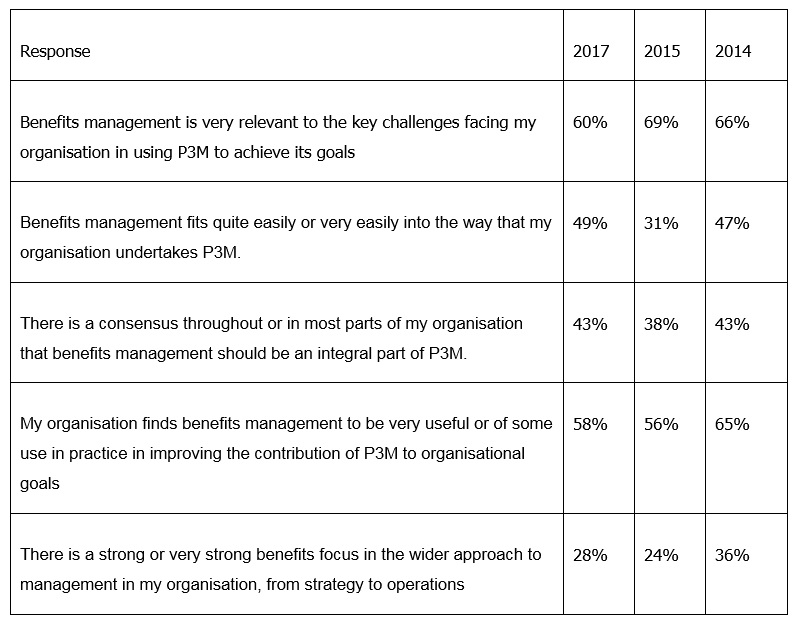APM Benefits Management SIG Survey of Members analysis, 2017
APM Benefits Management SIG Survey of Members analysis, 2017
In May 2017 the Benefits Management SIG undertook its third survey of members, to find out how benefits management is viewed in the organisations that members work for. The results of the survey can be accessed here and are summarised below, including comparisons with the 2014 and 2015 surveys.
The 2017 survey obtained 43 responses out of a SIG membership of over 1300. The number of respondents in 2014 was 44 and in 2015 it was 57. It might be assumed that members who are interested enough to undertake the survey are people with a particular interest in benefits management and a resilience to ‘survey fatigue’. Therefore, the sample is a small one and the results may not be representative of the Benefits Management SIG membership as a whole.
The respondents are almost all based in the UK, and work in a wide spread of industrial sectors. The category with the highest representation was ‘public administration, including defence’, which accounted for 33% of the 2017 respondents. Most of the questions asked were essentially the same as for 2014 and 2015, enabling comparisons to be drawn between the three surveys. The table below summarises the key results.

These results suggest that although benefits management is highly relevant to the project challenges facing organisations, in many cases it has had limited impact on organisational practices. This overall conclusion comes across from the 2017 results in a similar fashion to the results from previous years. Given the small size of the sample, no trends over time can be deduced from the data.
The 2017 and 2015 surveys included an open question, on which, if any, recognised methods from the guidance on benefits management have directly influenced the approach in the respondent's organisation. In 2017, 31 responses were received, of which six indicated that no methods are currently used. The most frequently referred to sources were the APMG Managing Benefits Guidance/Qualifications (mentioned seven times) and Managing Successful Programmes (mentioned five times). Some respondents indicated that they were promoting the adoption of specific guidance, with varying success.
A further open question invited participants to add further comments to explain their answers to the survey questions. In 2017, 16 responses were received. A common theme was hurdles to the adoption of benefits management, through factors such as lack of appetite at senior levels, lack of awareness/resources, lack of time to develop guidance, paying lip service to benefits and lack of practical examples.
A new question in 2017 asked about the job role of the respondent. The most common response was ‘Full-time project/programme manager’ (42%), followed by ‘PMO’ (24%) and ‘Business change/benefits related’ (21%).
A further new question in 2017 asked the respondents to choose up to three benefits-related competences which they have the most experience and confidence in delivering. 121 responses were received, compared to a maximum of 129 if every respondent identified three competences, suggesting a high level of interest in this question and high levels of experience/competence amongst participants. Many respondents identified the more strategic competences (such as creating BM strategy and other management documents, strategic alignment of initiatives and change management, stakeholder issues) in comparison to metrics-related competences (such as identifying KPI’s, identifying and quantifying non-financial benefits). Further questioning would be needed to identify if this was because strategic competences were viewed as more important, or whether there is a competence gap in metrics-related issues.
The survey suggests to the Benefits Management SIG Committee that there is a need to investigate in more detail why benefits management has not had more impact, including the barriers to its adoption and embedding in organisational practices and wider organisational cultures. The similarities in the responses in 2014, 2015 and 2017 suggest that the barriers are not yet being eroded over time.
Richard Breese
APM Benefits Management SIG committee member

0 comments
Log in to post a comment, or create an account if you don't have one already.